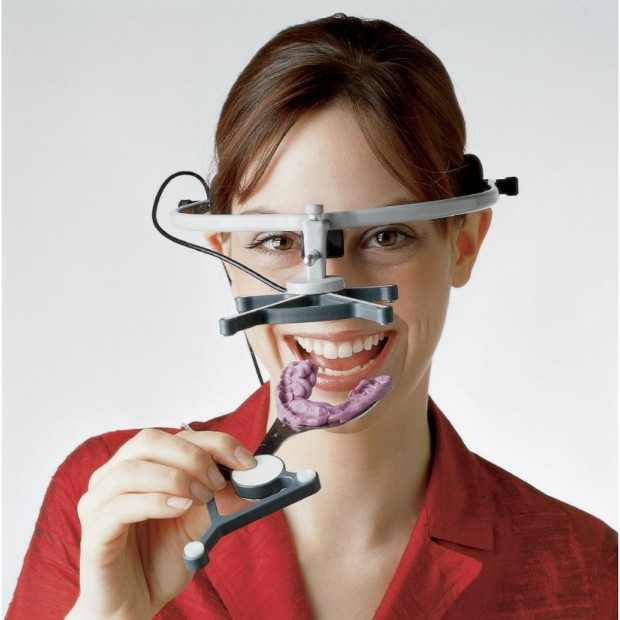Axiography of the TMJ

specialists

equipment

treatment
Advantages of digital axiography in the diagnosis of TMJ
Digital axiography provides high accuracy in the study of the temporomandibular joint. This method allows for detailed analysis of the numerous jaw movements required for chewing food and articulating speech.
Data obtained using digital axiography helps to select a treatment method. Disturbances in the functioning of the dental system, even minimal ones, can lead to serious consequences. Therefore, their timely detection and correction using digital technologies are important for maintaining the health and quality of life of patients. This approach allows for the most accurate restoration of TMJ function, ensuring long-term treatment results.

Modern technologies provide the following opportunities:
- Treatment planning Determining the sequence and methods of intervention to effectively eliminate pathologies
- 3D modeling Development of precise structures for the correction and restoration of TMJ functions
- Diagnosis of the causes of violations Identification of sources of dysfunction that provoked changes in the functioning of the joint
The influence of defects in orthopedic structures on the health of the TMJ

Incorrect use of orthopedic devices leads to serious consequences for the temporomandibular joint. The cause is such pathologies as:
- Increased load on the TMJ, which contributes to the development of arthrosis, arthritis and other degenerative changes
- Discomfort in the maxillofacial area, manifested by painful sensations
- Frequent headaches caused by joint dysfunction
- Pathological mobility of teeth, negatively affecting their safety
- Impairments in occlusion, leading to the abrasion of tooth enamel and the development of dental diseases
Accurate diagnosis using electronic axiography, which records jaw movements, provides the basis for successful treatment. Using data obtained from sensors and processed by specialized programs, doctors are able to predict the results of therapy and significantly increase its effectiveness. Considering that TMJ dysfunction affects a significant percentage of the population, timely correction and restoration of the dental system using axiography becomes a key point in preventing long-term negative consequences.
Criteria for the use of axiography in dentistry

The individual characteristics of jaw movement in each person require a unique approach to the diagnosis and treatment of pathologies of the dentofacial apparatus. Axiography in dentistry provides the opportunity for detailed analysis and is the method of choice under the following conditions:
- Identification of functional disorders of the TMJ
- Diagnostics of internal joint dysfunctions
- Assessing the condition before using occlusal splints and bite blocks
- Preparation for surgical interventions in the maxillofacial area
- Planning orthodontic treatment using braces, retainers and other orthopedic devices
- Development of a prosthetic scheme
The integrated use of axiography in clinical practice can significantly increase the effectiveness of treatment. This method is key in developing a treatment strategy tailored to the unique anatomical and functional characteristics of each patient, which leads to a successful and long-term result.

Modern methods of diagnostics and dental treatment at "K+31"
Our doctors

This award is given to clinics with the highest ratings according to user ratings, a large number of requests from this site, and in the absence of critical violations.

This award is given to clinics with the highest ratings according to user ratings. It means that the place is known, loved, and definitely worth visiting.

The ProDoctors portal collected 500 thousand reviews, compiled a rating of doctors based on them and awarded the best. We are proud that our doctors are among those awarded.
Make an appointment at a convenient time on the nearest date
Price
Other Services
Онлайн консультация стоматолога-ортопеда
Diagnosis and treatment of TMJ diseases Condylography of the TMJ MRI TMJ Splint therapy for TMJ Total dental rehabilitationOcclusion Analysis
Digital Smile Design (DSD) CEREC ceramic crowns, vineyards and deposits: 1 day manufacture and installation Boxing tire
















































Principles and application of axiography in dentistry
Axiography in dental practice is a method developed to study the functioning of the temporomandibular joint (TMJ), and is an important tool in the work of gnathologists, orthopedists and orthodontists. The essence of the method is to record jaw movements, identify pathologies and their causes. During the diagnostic process, two types of data recording are used:
Specialized ultrasonic axiograph sensors record movements, thereby providing the opportunity for a detailed analysis of the operation of the TMJ. Based on the collected data, a computer program generates a visualization that allows the doctor to evaluate the anatomy and physiology of the joint, including the parameters of the joint space, the contours of the fossae, and the relative positions of the structures. Occlusal relationships, the central relationship of the jaws, as well as pathological changes, such as displacement of the intra-articular disc, symmetry of the TMJ, become obvious to the specialist.
As a result of diagnostics, it is possible not only to study the bite and individual characteristics of the patient in detail, but also to develop an accurate treatment plan, including the selection of prostheses and devices, as well as a preview of the results of the upcoming therapy. The advantage of digital axiography is the ability to accurately model the jaw structure and an integrated approach to treatment, taking into account all aspects of the functioning of the TMJ.